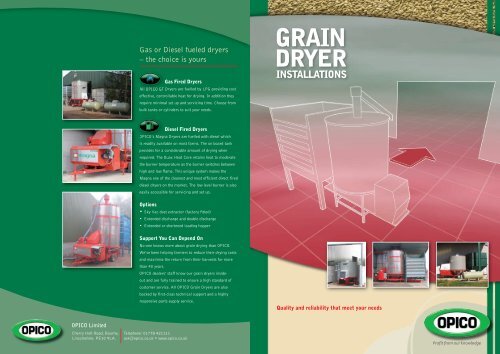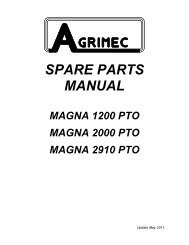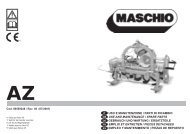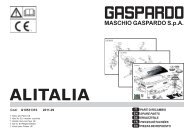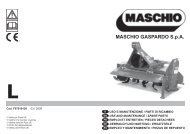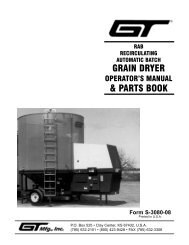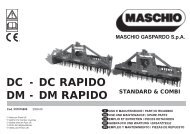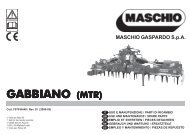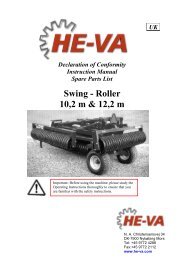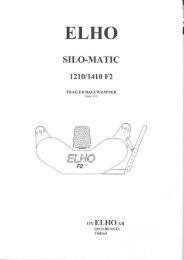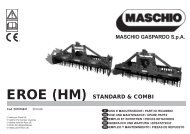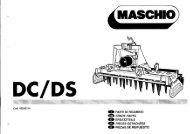You also want an ePaper? Increase the reach of your titles
YUMPU automatically turns print PDFs into web optimized ePapers that Google loves.
Gas or Diesel fueled <strong>dryer</strong>s<br />
– the choice is yours<br />
GRAIN<br />
DRYER<br />
INSTALLATIONS<br />
Gas Fired Dryers<br />
All OPICO GT Dryers are fuelled by LPG providing cost<br />
effective, controllable heat for drying. In addition they<br />
require minimal set up and servicing time. Choose from<br />
bulk tanks or cylinders to suit your needs.<br />
Diesel Fired Dryers<br />
OPICO’s Magna Dryers are fuelled with diesel which<br />
is readily available on most farms. The on board tank<br />
provides for a considerable amount of drying when<br />
required. The Duax Heat Core retains heat to moderate<br />
the burner temperature as the burner switches between<br />
high and low flame. This unique system makes the<br />
Magna one of the cleanest and most efficient direct fired<br />
diesel <strong>dryer</strong>s on the market. The low level burner is also<br />
easily accessible for servicing and set up.<br />
Options<br />
• Sky Vac dust extractor (factory fitted)<br />
• Extended discharge and double discharge<br />
• Extended or shortened loading hopper<br />
Support You Can Depend On<br />
No-one knows more about <strong>grain</strong> drying than OPICO.<br />
We’ve been helping farmers to reduce their drying costs<br />
and maximise the return from their harvests for more<br />
than 40 years.<br />
OPICO dealers’ staff know our <strong>grain</strong> <strong>dryer</strong>s insideout<br />
and are fully trained to ensure a high standard of<br />
customer service. All OPICO Grain Dryers are also<br />
backed by first-class technical support and a highly<br />
responsive parts supply service.<br />
Quality and reliability that meet your needs<br />
OPICO Limited<br />
Cherry Holt Road, Bourne,<br />
Lincolnshire. PE10 9LA.<br />
Telephone: 01778 421111<br />
ask@<strong>opico</strong>.co.uk • www.<strong>opico</strong>.co.uk<br />
Profit from our knowledge
GETTING THE<br />
MOST FROM<br />
YOUR OPICO<br />
GRAIN DRYER<br />
OPICO Grain Dryers offer you unrivalled<br />
flexibility to enable you to fit them in to many<br />
different drying and storage layouts.<br />
With a little thought about the flow of wet and dry <strong>grain</strong><br />
and minimal alterations to existing buildings, an efficient<br />
drying process can be set up.<br />
The key is planning a layout that avoids double handling -<br />
minimising labour input maximises the financial efficiency<br />
and drying throughput.<br />
Many farms could increase drying output at minimal<br />
additional cost by simply arranging their system better.<br />
Electric drive and fully automated <strong>dryer</strong>s are another good<br />
way of increasing drying output per day without increasing<br />
the size of the <strong>dryer</strong> being used.<br />
Whichever control system you choose, ease of management<br />
and peace of mind are key benefits of owning an OPICO<br />
Dryer. Once set for a specific crop type the <strong>dryer</strong> looks after<br />
the drying process itself. If there is any problem it will<br />
either shut the burner off or shut down the <strong>dryer</strong> completely<br />
When siting your <strong>dryer</strong>, consider the <strong>grain</strong> flow around<br />
the farm to minimise double handling<br />
Choose a covered, ventilated environment for your <strong>dryer</strong><br />
The prevailing wind should ideally be in the direction of<br />
the fan<br />
Take advantage of expert advice in the siting of the bulk<br />
or cylinder Liquid Propane Gas supply and diesel storage<br />
Grain is discharged from OPICO Dryers at height - use<br />
gravity to help you move the <strong>grain</strong> to where it needs to be<br />
Even in a dry year put your <strong>grain</strong> through the <strong>dryer</strong> -<br />
it will polish it up and improve its appearance and<br />
hectolitre weight<br />
Positioning<br />
There are a wide range of options<br />
when it comes to choosing the right<br />
location for your new <strong>dryer</strong>.<br />
However always consider the following guidelines<br />
to ensure you get the best possible return from<br />
your investment.<br />
First and foremost, think carefully about the flow of<br />
<strong>grain</strong> through your farm. Choose a site that avoids or<br />
minimises downtime when filling and emptying. Ideally,<br />
your <strong>dryer</strong> should be sited in a well ventilated area and<br />
have cover overhead to protect it from the weather.<br />
1 Positioning multiple <strong>dryer</strong>s nearby makes management easier<br />
2 If Dryers are sited inside a shed, condensation will be a<br />
problem unless there is a through draft to take the hot moist<br />
air away from the <strong>dryer</strong><br />
3 A purpose built installation with excellent positioning for fuel,<br />
ventilation and some protection from the weather<br />
4 Use the natural fall of the ground to help minimise the need<br />
for additional augers and conveyors<br />
5 If the installation is permanent then protect the <strong>dryer</strong> from<br />
the prevailing weather by using Yorkshire boarding which still<br />
allows ventilation<br />
6 A simple extension to an existing store provides cover and<br />
ventilation as well as access<br />
7,8,9<br />
Incorporating all the Positioning elements, Picture 7 shows<br />
loading from inside the store and where the discharge is<br />
unloading the <strong>grain</strong>. Pictures 8 and 9 show the Dryer and Pre<br />
store hopper sited under a lean-to protecting them from the<br />
elements but ensuring ventilation to eradicate damp moist air<br />
1 2<br />
3<br />
4<br />
5 6<br />
7 8 9
Filling<br />
OPICO Dryers can fill themselves from<br />
their reception hopper at between ¾<br />
and 1½ tons per minute.<br />
If there is not enough <strong>grain</strong> to satisfy this demand then<br />
the drying cycle will be extended and the <strong>dryer</strong>s<br />
throughput reduced.<br />
Site the Dryer as close to the wet <strong>grain</strong> as possible. If loading<br />
with a materials handler use a feed hopper preloaded to<br />
ensure the demand from the loading auger can be met. With<br />
Automatic Dryers match the feed hopper to multiples of the<br />
capacity of the Dryer itself.<br />
1 2<br />
3<br />
1 An 18 ton Automatic Dryer with a matched 18 ton<br />
pre-storage hopper which is loaded with wet <strong>grain</strong> stored<br />
inside the shed behind<br />
2 A 12 ton Dryer takes the full capacity of the 12 ton trailers’<br />
<strong>grain</strong> chute to fill at maximum speed<br />
3 A sunken loading hopper allows filling with a trailer straight<br />
from the field or with wet <strong>grain</strong> stored nearby<br />
4 A buffer hopper to ensure the Dryer is filled as quickly as the<br />
loading hopper is able to take <strong>grain</strong><br />
5 An adjustable sluice to control the flow of <strong>grain</strong> is required<br />
with some designs of pre-store hopper<br />
6 Bespoke intake hopper allows <strong>dryer</strong> to be integrated into an<br />
existing <strong>grain</strong> handling system<br />
4<br />
5 6<br />
7,8<br />
A sunken <strong>dryer</strong> with <strong>grain</strong> walled loading area to allow a<br />
substantial amount of <strong>grain</strong> to be piled up and feed the Dryer.<br />
This prevents double handling as <strong>grain</strong> can be tipped into the<br />
loading area straight from the field rather than being tipped<br />
and moved with a handler. Beware not to place too much<br />
<strong>grain</strong> above the loading hopper without some sort of baffle to<br />
prevent the weight of <strong>grain</strong> crushing the hopper<br />
7 8 9<br />
9 Reception pit allows tipping straight from the field or filling<br />
with the handler from a wet <strong>grain</strong> heap<br />
Ensure wet <strong>grain</strong> storage capacity and auger<br />
capacities are matched to the Dryers loading capacity!
Emptying<br />
One of the advantages of a<br />
recirculating Batch Dryer is that<br />
it discharges from height.<br />
So with some planning and the help of gravity, <strong>grain</strong> can<br />
be moved to a storage area without the use of conveyors.<br />
Dryers can be fitted with a variety of discharge options to<br />
suit particular installations and automatic <strong>dryer</strong>s can be<br />
specified to provide control and power to auxiliary<br />
conveyors if required.<br />
Many farms use <strong>dryer</strong>s to fill lorries and trailers so that no<br />
additional handling is required after drying the <strong>grain</strong>.<br />
The high discharge speed of all OPICO Dryers means that any<br />
auxiliary conveyors need to have a high capacity or buffer<br />
storage to help them keep up.<br />
1 A common and low cost system is to discharge from outside<br />
a <strong>grain</strong> store through the cladding above the <strong>grain</strong> walling<br />
2 More permanent installations should be fitted with a flange<br />
to seal the cladding<br />
3 Electric or hydraulic horizontal discharge augers can be<br />
specified and used to control the speed of emptying<br />
4 In the simplest of systems several batches of <strong>grain</strong> are left<br />
to unload before a materials handler is used to move the <strong>grain</strong><br />
around the store and heap it up<br />
5 An 18 ton <strong>dryer</strong> fitted with twin horizontal discharge to allow<br />
lorries to be filled or <strong>grain</strong> to be emptied into a storage bin<br />
6 Support must be provided for extended horizontal<br />
discharge augers<br />
THE PROCESS FROM<br />
WET TO DRY GRAIN<br />
Whether using a simple PTO Drive or a fully automated 3<br />
phase Dryer you need to keep the Dryer full for as much of<br />
the time as possible to achieve the maximum productivity<br />
in a day. This means allowing the Dryer unrestricted<br />
loading and unloading. As all OPICO Dryers are fitted with<br />
high capacity intake and discharge augers this has to be<br />
accounted for when integrating them into a system.<br />
Similarly the whole harvesting operation can be slowed<br />
down by the intake system if trailers cannot be tipped<br />
immediately, unloading <strong>grain</strong> trailers via the <strong>grain</strong> chute is<br />
one of the worst ways as it slows the operation<br />
down considerably.<br />
The reception pit can be<br />
loaded by a materials handler<br />
when a wet <strong>grain</strong> pile has<br />
built up and trailers are not<br />
coming in from the field<br />
A reception pit built into the<br />
floor inside the <strong>grain</strong> store<br />
allows trailers to be tipped<br />
quickly but would require a<br />
large capacity auger to feed<br />
straight into a Dryer without<br />
a pre store bin<br />
The transfer auger is then<br />
loaded from the undercover<br />
sunken reception pit<br />
The pre storage hopper, which<br />
is matched to the size of the<br />
Dryer, is gradually loaded<br />
whilst the Dryer is at work on<br />
the previous load<br />
1 2<br />
3<br />
The pre store hopper can also<br />
be loaded directly by a materials<br />
handler if required, whichever<br />
way it is full by the time the<br />
previous load is finished<br />
4<br />
5 6<br />
A horizontal discharge auger<br />
discharges through the<br />
cladding and over the <strong>grain</strong><br />
walling of the dry <strong>grain</strong> shed to<br />
finish the process


